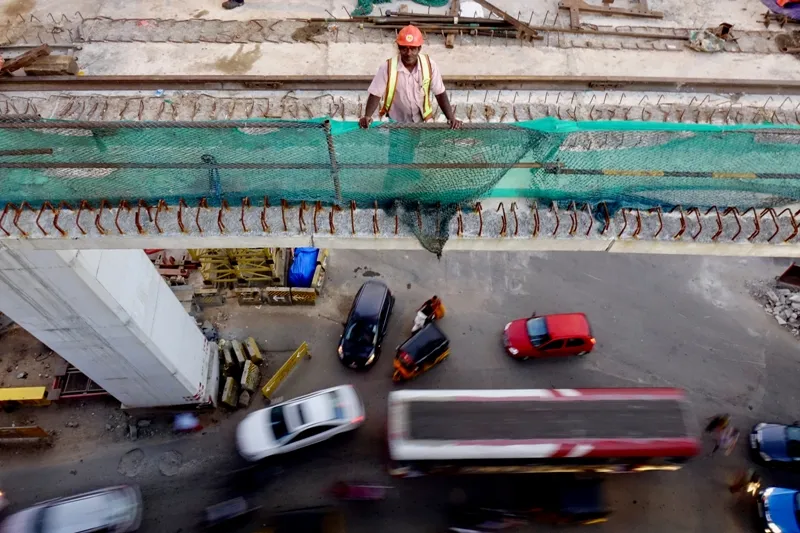-
CENTRES
Progammes & Centres
Location
The Special Economic Zones Act was, and still remains, a difficult legislation to turn into action.

Image Source: Rajesh Pamnani — Flickr/CC BY-NC-ND 2.0 [Representative image]
As of 31 March 2017, there are 218 SEZs in operation.
The following is a chapter from the book 70 Policies that Shaped India: 1947 to 2017, Independence to $2.5 Trillion.
Find the book here.
To provide fiscal incentives to industrialisation, infrastructure and technology, the instrument of a special economic geography was created in 1965 in Gujarat with the setting up of the Kandla Free Trade Zone, Asia’s first, <1> to substitute the Karachi Port with the Kandla Port. <2> Along with the Santa Cruz Export Processing Zone, the two were the only ‘economic zones’ in India. Following the failure to speed up processes due to cumbersome procedures and red tape, governments at the centre as well as in the states have been modifying rules to deliver outcomes. In just six years, between 1978 and 1984, there were seven attempts to fix the problem: a committee to look into the problem hindering the growth of KAFTZ (1978); Alexander Committee on Import & Export Policies (1978); Review Committee on Electronics (1979); Dagli Committee on Controls and Subsidies (1979); Tondon Committee on Export Strategy (1980); Committee on FTZs and 100 percent EOUs (1982); and Abid Hussain Committee on Trade policy (1984). <3> Finally, on 23 June 2005, Parliament enacted the Special Economic Zones Act for the establishment, development and management of SEZs for the promotion of exports. <4> This was, and still remains, a difficult legislation to turn into action. Part of the problem is that the legislation and regulation of SEZs is a concurrent subject and different states have varying objectives. Karnataka wanted it to attract foreign investment; Tamil Nadu sought large dividends; Andhra Pradesh, West Bengal and Kerala pushed for employment generation; Maharashtra aimed for ease in doing business through simple procedures; and Uttar Pradesh wanted to promote industrial and economic growth. <5> Six states enacted their own SEZ Acts: Madhya Pradesh <6> and West Bengal <7> in 2003, Gujarat <8> in 2004, Haryana <9> and Tamil Nadu <10> in 2005, and Punjab <11> in 2009. On 31 March 2017, there were 218 SEZs in operation, largely in the information technology sector, employing 1.7 million workers, and delivering exports of more than Rs. 500,000 crore. <12>
<1> Special Economic Zones (SEZs) and Export Oriented Units (EOUs), Annual Report 2011–2012, Department of Commerce, Ministry of Commerce and Industry, Government of India, 81, accessed 4 January 2018.
<2> Malini L. Tantri, “Special Economic Zones in India: Policy, Performance and Prospects,” Cambridge University Press, 9 May 2016, 12.
<3> Malini L. Tantri, “India’s SEZ Policy: A Retrospective Analysis, The Institute for Social and Economic Change, 2013,” 29, accessed 4 January 2018.
<4> Special Economic Zones Act, 2005, The Gazette of India, Ministry of Law and Justice, Government of India, 23 June 2005, accessed 4 January 2018.
<5> Malini L. Tantri, op. cit., 9.
<6> The Indore Special Economic Zone (Special Provisions) Act, 2003, Special Economic Zones in India, Department of Commerce, Ministry of Commerce and Industry, 28 March 2003, accessed 4 January 2018.
<7> The West Bengal Special Economic Zone Act, 2003, Special Economic Zones in India, Department of Commerce, Ministry of Commerce and Industry, accessed 4 January 2018.
<8> The Gujarat Special Economic Zone ACT, 2004, The Gujarat Government Gazette, 30 March 2004, accessed 4 January 2018.
<9> The Haryana Special Economic Zone Act, 2005, Legislative Department, Government of Haryana, 17 January 2006, accessed 4 January 2018.
<10> Tamil Nadu Special Economic Zones (Special Provisions) Act, 2005, Tamil Nadu Government Gazette, 14 October 2005, 103–111, accessed 4 January 2018.
<11> The Punjab Special Economic Zones Act, 2009, Department of Legal and Legislative Affairs, Government of Punjab, 24 September 2009, accessed 4 January 2018.
<12> Nirmala Sitharaman, Minister of State in the Ministry of Commerce and Industry (Independent Charge), Starred Question No 213, Lok Sabha, 31 July 2017, accessed 4 January 2018, http://164.100.47.190/loksabhaquestions/annex/12/AS213.pdf.
The views expressed above belong to the author(s). ORF research and analyses now available on Telegram! Click here to access our curated content — blogs, longforms and interviews.

Gautam Chikermane is Vice President at Observer Research Foundation, New Delhi. His areas of research are grand strategy, economics, and foreign policy. He speaks to ...
Read More +